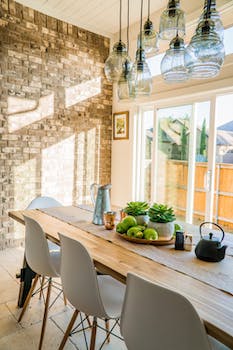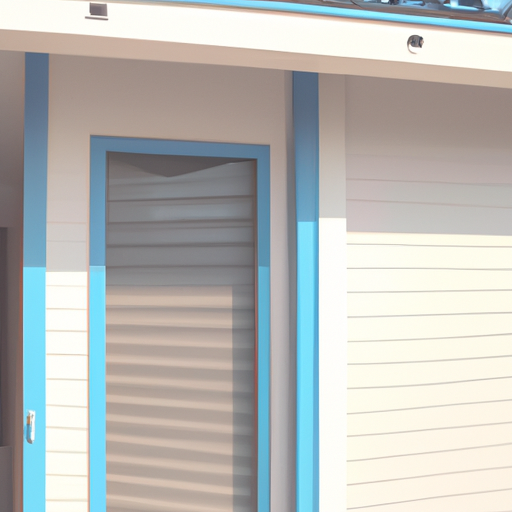Maximizing Natural Light: The Role of Window Placement in Home Design
The impact of window placement on your home’s architecture cannot be overstated. Windows play a crucial role in defining the character and aesthetic appeal of a building, while also serving functional purposes such as providing natural light, ventilation, and views. As such, the strategic placement of windows is an essential aspect of home design that can significantly influence the overall look and feel of your living space. This article will explore the role of window placement in maximizing natural light and enhancing the architectural appeal of your home.
Natural light is a vital element in creating a comfortable and inviting living environment. It not only enhances the visual appeal of a space but also offers numerous health benefits, such as improving mood, boosting productivity, and promoting better sleep. Therefore, it is essential to consider the orientation and placement of windows to maximize the amount of natural light that enters your home.
One of the primary factors to consider when positioning windows is the direction they face. In general, north-facing windows provide consistent, indirect sunlight throughout the day, making them ideal for spaces that require even lighting, such as art studios or reading rooms. South-facing windows, on the other hand, receive direct sunlight for most of the day, which can create a warm and bright atmosphere in living areas and bedrooms. East and west-facing windows offer a balance of direct and indirect sunlight, with east-facing windows capturing the morning sun and west-facing windows basking in the afternoon light.
Another critical aspect of window placement is the size and shape of the windows. Larger windows allow more natural light to enter a space, creating a brighter and more open atmosphere. However, it is essential to strike a balance between maximizing light and maintaining privacy, particularly in bedrooms and bathrooms. In these spaces, consider using smaller windows or incorporating window treatments such as blinds or curtains to control the amount of light and visibility.
The height of windows also plays a significant role in determining the amount of natural light that enters a room. Higher windows can capture more sunlight, particularly in rooms with tall ceilings. Additionally, clerestory windows – a series of small, high windows placed near the ceiling – can be an effective way to introduce light into a space without compromising privacy or wall space for artwork and furniture.
Window placement can also impact the energy efficiency of your home. Properly positioned windows can help regulate indoor temperatures by allowing sunlight to warm the space during colder months and providing natural ventilation during warmer months. This can reduce the reliance on artificial heating and cooling systems, leading to lower energy consumption and costs.
Lastly, the architectural style of your home should also influence your window placement decisions. For example, modern homes often feature large expanses of glass to create a seamless connection between indoor and outdoor spaces, while traditional homes may incorporate smaller, more evenly spaced windows to maintain a sense of symmetry and balance.
In conclusion, the strategic placement of windows is a crucial aspect of home design that can significantly impact the overall look, feel, and functionality of your living space. By considering factors such as orientation, size, shape, and height, you can maximize natural light, enhance energy efficiency, and create a visually appealing and comfortable environment for you and your family. As you plan your next home renovation or new build, be sure to consult with an architect or designer to ensure that your window placement decisions align with your desired aesthetic and functional goals.
Balancing Aesthetics and Functionality: How Window Placement Affects Your Home’s Architecture

The impact of window placement on your home’s architecture cannot be overstated. Windows play a crucial role in defining the overall aesthetic appeal and functionality of a building. They are responsible for providing natural light, ventilation, and views, while also contributing to the energy efficiency and comfort of the occupants. As such, it is essential to strike a balance between aesthetics and functionality when determining the optimal window placement for your home.
One of the primary considerations when it comes to window placement is the orientation of the building. The direction your home faces will significantly influence the amount of sunlight it receives throughout the day. For instance, south-facing windows will allow for maximum sunlight exposure, which can be beneficial in colder climates where passive solar heating is desired. On the other hand, east and west-facing windows can result in excessive heat gain during the summer months, making it essential to consider shading devices or energy-efficient glazing options.
Another critical factor to consider is the size and proportion of the windows. Large windows can create a sense of openness and connection with the outdoors, while smaller windows can provide a more intimate and cozy atmosphere. However, it is essential to balance the desire for large windows with the need for privacy and energy efficiency. Oversized windows can lead to increased heat loss during the winter months and may require additional insulation or high-performance glazing to maintain comfortable indoor temperatures.
The placement of windows also plays a significant role in determining the overall aesthetic appeal of your home. Windows can be used to create visual interest and break up large expanses of wall, while also providing a sense of rhythm and balance to the façade. For example, placing windows symmetrically along the front elevation can create a sense of order and formality, while a more random arrangement can result in a more casual and organic appearance.
In addition to the exterior appearance, window placement can also impact the interior layout and functionality of your home. Windows should be strategically placed to maximize natural light and ventilation in living spaces, while also providing views and a connection to the outdoors. For instance, placing windows on opposite sides of a room can create a cross breeze, which can help to naturally cool the space during the summer months. Similarly, positioning windows near work surfaces in kitchens and bathrooms can provide task lighting and improve the overall usability of the space.
It is also essential to consider the relationship between window placement and the surrounding landscape. Windows can be used to frame views of the garden or other natural features, creating a strong connection between the interior and exterior spaces. Additionally, the placement of windows can impact the privacy of your home, both from the street and from neighboring properties. Careful consideration should be given to the placement of windows in relation to sightlines and potential privacy concerns.
In conclusion, the impact of window placement on your home’s architecture is multifaceted, encompassing both aesthetic and functional considerations. By carefully considering factors such as orientation, size, proportion, and the relationship with the surrounding landscape, homeowners can achieve a balance between aesthetics and functionality that enhances the overall architectural appeal and livability of their home. As a result, window placement should not be an afterthought but rather an integral part of the design process, ensuring that your home is both beautiful and comfortable for years to come.
Energy Efficiency and Comfort: The Importance of Strategic Window Placement in Modern Homes
The impact of window placement on a home’s architecture cannot be overstated. Windows play a crucial role in determining the overall aesthetic appeal, energy efficiency, and comfort of a home. Strategic window placement can significantly enhance the architectural design of a house, while also providing numerous practical benefits. In modern homes, where energy efficiency and comfort are of paramount importance, the significance of strategic window placement is even more pronounced.
One of the primary functions of windows is to provide natural light and ventilation. Properly placed windows can maximize the amount of sunlight that enters a home, reducing the need for artificial lighting and thereby lowering energy consumption. Moreover, windows that are strategically placed to take advantage of prevailing winds can help to naturally ventilate a home, reducing the reliance on air conditioning systems and further contributing to energy efficiency.
In addition to their role in promoting energy efficiency, windows also play a crucial part in determining the thermal comfort of a home. Windows are typically the weakest point in a building’s thermal envelope, as they allow for heat transfer between the interior and exterior environments. By carefully considering the placement and size of windows, homeowners can minimize heat loss in the winter and heat gain in the summer, ensuring a comfortable living environment year-round.
The orientation of a home is a critical factor in determining the optimal placement of windows. In the northern hemisphere, south-facing windows receive the most sunlight throughout the day, making them ideal for maximizing natural light and passive solar heating. Conversely, north-facing windows receive the least amount of sunlight and should be minimized to reduce heat loss. East and west-facing windows can provide morning and afternoon sunlight, respectively, but can also contribute to unwanted heat gain during the summer months. By taking these factors into account, homeowners can strategically place windows to optimize energy efficiency and comfort.
Window placement also has a significant impact on the visual appeal of a home’s architecture. Windows can serve as focal points, drawing attention to specific architectural features or providing a sense of balance and symmetry. The size, shape, and style of windows can also contribute to the overall aesthetic of a home, with larger windows creating a sense of openness and smaller windows adding a sense of coziness. By carefully considering the placement and design of windows, homeowners can enhance the architectural appeal of their homes while also achieving practical benefits.
In addition to the placement of windows, the choice of window materials and glazing options can also have a significant impact on a home’s energy efficiency and comfort. Double or triple-glazed windows with low-emissivity coatings can help to minimize heat transfer, while also reducing the amount of ultraviolet radiation that enters a home, protecting furnishings from fading. Furthermore, the use of energy-efficient window frames, such as those made from wood, fiberglass, or vinyl, can further contribute to a home’s overall energy performance.
In conclusion, the strategic placement of windows in modern homes is of utmost importance in achieving energy efficiency, comfort, and architectural appeal. By carefully considering factors such as orientation, size, and style, homeowners can optimize the benefits of natural light and ventilation, while also enhancing the visual appeal of their homes. Furthermore, the choice of energy-efficient window materials and glazing options can further contribute to a home’s overall performance, ensuring a comfortable and sustainable living environment for years to come.
Q&A
Question 1: How does window placement affect the overall aesthetics of a home’s architecture?
Answer 1: Window placement significantly impacts the overall aesthetics of a home’s architecture by influencing the balance, symmetry, and visual appeal of the exterior. Properly placed windows can enhance the architectural style, create a sense of harmony, and allow for optimal natural light inside the home.
Question 2: How can window placement impact energy efficiency in a home?
Answer 2: Window placement plays a crucial role in a home’s energy efficiency by affecting heat gain and loss, natural ventilation, and daylighting. Strategically placed windows can maximize solar heat gain in winter and minimize it in summer, reducing the need for artificial heating and cooling. Additionally, well-placed windows can promote cross-ventilation, reducing the reliance on air conditioning, and provide ample natural light, reducing the need for artificial lighting.
Question 3: What factors should be considered when determining window placement in a home’s design?
Answer 3: Factors to consider when determining window placement in a home’s design include the home’s architectural style, orientation, climate, views, privacy, and the intended function of each room. It is essential to balance aesthetics, energy efficiency, and practicality to achieve optimal window placement that enhances the home’s overall design and functionality.
Conclusion
In conclusion, window placement significantly impacts a home’s architecture by influencing natural light distribution, energy efficiency, aesthetics, and functionality. Thoughtful window placement can enhance a home’s visual appeal, improve indoor comfort, and contribute to energy savings, making it a crucial aspect of architectural design.


